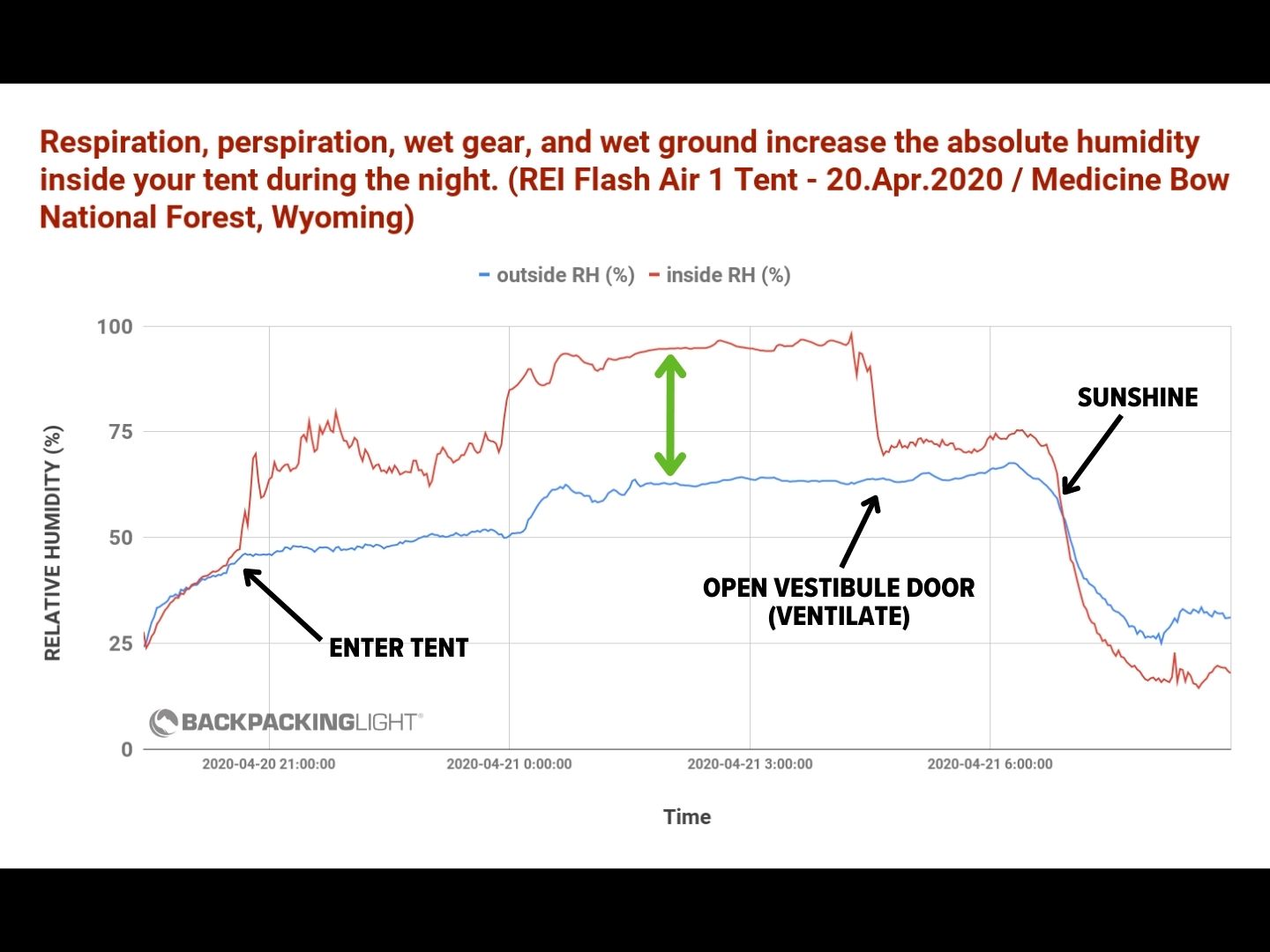Introduction
It’s often assumed that relative humidity (RH) is the primary measure used to predict the probability that condensation will form on the inside of a tent.
However, RH is sensitive to temperature (for the condition where absolute humidity remains the same). So while high RH at low temperatures may result in condensation, the same RH at a higher temperature may not result in condensation.
For the past several decades, vapor pressure differential (VPD) has been used in a variety of environmental and climate engineering disciplines, including the building industry, greenhouse farming, and evaporating/condensing reactors of various types.
However, it’s rarely discussed in the context of tent condensation. Yet, it remains the fundamental thermodynamic principle that helps us understand the probability that condensation will occur on a tent fabric surface in a given environmental condition.
Watch the Video

How Does Temperature Impact Relative Humidity?
Two things happen every single night you camp:
- temperature drops, and
- relative humidity (RH) rises.
Let’s explore how temperature and RH impact condensation.
Here’s a graph of actual measurements I took on a Wilderness trip in July of 2022 where I’m measuring the inside and outside temperatures and relative humidities:

I’m using a Tarptent Dipole 1 Li in this case. You can see from the red line that as the evening proceeds the temperature drops and then as morning comes the temperature rises.
Likewise, the RH inside the tent increases throughout the night, and drops after sunrise.
Consider what happens to RH as the temperature drops:

Focus on the blue line for now. On the right-hand side of the graph, you have the condition where the temperature is 70 °F (as you might encounter when pitching your tent in the afternoon). As the evening cools, the temperature will decrease and you’ll move along the line to the left.
For example, as you get ready to go to bed the temperature has dropped into the 50s °F. As temperature drops, the RH inside your tent will rise because of a temperature change: colder air has a lower capacity to store water vapor than warmer air so as the air cools, RH increases.
For air originally having an RH of 15% at 70 °F, you can see that by the time the air cools to 50 °F, the RH is now more than 30%.
The blue line represents the kind of environmental condition you might experience in the desert or perhaps mid-summer in the southern Rockies.
The red line shows a starting RH of about 25% at 70 °F. This is representative of a typical mid-summer condition along the coastal ranges of Washington, Oregon, and California.
The yellow line shows the case of air cooling when RH is 50% at 70 °F and this is what you might find in the New England states during the summer.
Note that the red and yellow lines both reach 100% RH as the air cools (the blue line will also cool to the point where it reaches 100% RH, but that temperature is off to the left side of the graph).
The red line reaches 100% RH at a temperature in the low 30s °F and the yellow line reaches 100% RH as it approaches 50 °F. At 100% RH, air can no longer hold any more water vapor and that water vapor has to go somewhere. That somewhere is usually a surface that’s in contact with the air like your tent fabric – therefore, condensation occurs when RH is 100%.
What Happens When You Enter Your Tent at Night?
A second thing happens while you’re in camp: as you enter your tent you respire and perspire and contribute to the moisture load. In addition, additional moisture may enter the inside of your tent as a result of wet gear or wet ground.
This graph shows the results of a continuous environmental monitoring experiment that I did with the REI Flash Air 1 tent back in 2020:

The blue line shows the RH outside my tent and the red line shows the RH inside my tent.
You can see on the left-hand side of the graph that inside RH% and outside RH% are about the same until I enter the tent at around 10 o’clock that night. At that time I’m starting respiring and perspiring inside my tent. Now, you see that inside RH% (red) increases significantly.
The green double arrow shows the difference in RH between inside and outside air. Throughout the night you see a rise in RH% inside the tent.
At about 4:30 AM I get up to go to the bathroom and when I come back to bed I find a lot of condensation in the tent. I open the door and roll it back and ventilate the tent as much as possible. Now, you can see the effects of that air exchange between the drier outside air and the wetter inside air. Also, note the gap between the inside and outside RH narrow.
Once the sun rises and hits the tent you can actually see the inside RH become lower than the outside RH, which is a very unusual condition created when the temperature inside the tent rises dramatically above the outside temperature.
Why Does Condensation Occur at RH% Less than 100%?
It’s obvious that condensation occurs when the RH reaches 100%.
However, we often see condensation form at RH levels that are well less than 100%. Why?
Member Exclusive
A Premium or Unlimited Membership* is required to view the rest of this article.
* A Basic Membership is required to view Member Q&A events




Home › Forums › Using vapor pressure differential to predict condensation in tents